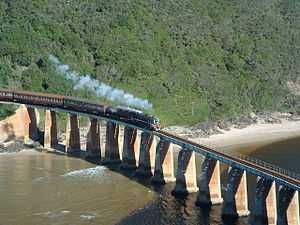Outeniqua Choo Tjoe


The Outeniqua Choo Tjoe was the last remaining continually-operated passenger steam train in Africa, ending operation in June 2009. The railway was completed in 1928, and links the towns of George and Knysna in the Western Cape, South Africa. The 3 hour journey also stops in the towns of Wilderness, Goukamma, and Sedgefield. The scenic 67-kilometre (42 mi) route hugs the rugged coastline of the Garden Route before ending by crossing a bridge over the lagoon in Knysna.
It was declared an officially preserved railway in 1992, carrying about 40,000 passengers per year at the time. A decade later, it carried 115,000 passengers per year, 70% of whom were foreign tourists.
The trains are usually pulled by SAR Class 19D steam locomotives, of 4-8-2 wheel arrangement with Vanderbilt-like "torpedo" tenders, although the task is occasionally handled by SAR Class 24 steam engines. When dry conditions in the summer increase the risk of wildfires, diesel locomotives (SAR Class 32s) are used instead.
During August 2006 the line was damaged due to heavy flooding.[1] As of November 2006 it was rescheduled to run between George and Mossel Bay (with a stop at Hartenbos).[2]
In 2008, the train and the Kaaiman's River Bridge were featured in a television advertisement for Stella Artois.
In 2007, the train's owners, Transnet Limited, announced that the train was not regarded as part of its core business. Transnet initiated a tender process to dispose of the train to a new owner/operator. However, on August 19, 2010 Transnet announced that, following unsuccessful attempts to find such a new operator, the train would cease operating. Nonetheless, the Western Cape Province's Finance, Economic Development and Tourism Minister, Alan Winde, says he is resolved to keep this heritage tourism asset operational.[3]
References
- ↑ "Outeniqua Choo-tjoe History".
- ↑ Mulder, Jane (November 28, 2006). "Choo-Tjoe train back in action". IOL Travel.
- ↑ "Outeniqua Choo-Tjoe Reaches End of the Line". August 24, 2010.
External links
| Wikimedia Commons has media related to Outeniqua Choo Tjoe. |
- Official Site of the Outeniqua Choo Tjoe and Transnet Heritage Museum
- Friends of the Chooe Tjoe
- Outeniqua Choo-Tjoe Webcam
- South African Heritage Rail Discussion Forum at Friends of the Rail